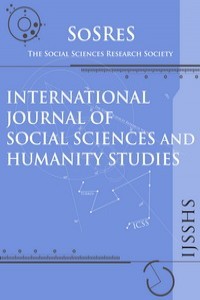THE RELATIONSHIP OF THE ETHICAL LEADERSHIP AMONG THE ORGANIZATIONAL TRUST, AFFECTIVE COMMITMENT AND JOB SATISFACTION: CASE STUDY OF A UNIVERSITY
THE RELATIONSHIP OF THE ETHICAL LEADERSHIP AMONG THE ORGANIZATIONAL TRUST, AFFECTIVE COMMITMENT AND JOB SATISFACTION: CASE STUDY OF A UNIVERSITY
___
- Allen, N. J., Meyer, J. P. (1990), “The measurement and antecedents of affective continuance and normative commitment to the organization”, Journal of
- Occupational Psychology, 63(1), pp.1-18. Allen, N. J., Meyer, J. P. (1996), “Affective, continuance and normative commitment to the organization: an examination of interactive effects of outcomes and procedures”, Psychological Bulletin, 2(120), pp.189-208.
- Baron, R. M., ve Kenny, D. A. (1986), “The moderator-mediator variable distinction in social psychological research: Conceptual, strategic, and statistical considerations”, Journal of Personality and Social Psychology, 51, pp.1173-82.
- Bromiley, P. ve L.L. Cummings (1996), “The Organizational Trust Inventory
- (OTI)”, Roderick M. Kramer ve Tom R. Tyler (Der.), Trust in Organizations, Thousand Oaks: Sage, pp.302-319. Brown, M. E. ve Trevino, L. K., Harrison, D. A. (2005), “Ethical Leadership: A
- Social Learning Perspective for Construct Development and Testing”, Organizational Behavior and Human Decision Processes, 97,pp.117-134. Brenkert, George G. (1998), “Trust, morality and international business”,
- Business Ethics Quarterly (BEQ), 8(2), pp.293-317. Brown, M. E. & L. K. Trevino (2006), “Ethical Leadership: A Review and Future
- Directions”, The Leadership Quarterly, 17, pp.595-616. Gill, A. S. (2008), “The role of trust in employee-manager relationship”,
- International Journal of Contemporary Hospitality Management, 20, pp.98-103. Iverson, R. D., Buttigieg, D. M. (1999), “Affective, normative and continuance commitment: can the ‘right kind’ of commitment be managed?”, Journal of
- Management Studies, 36(3), pp.307-333. Kim WG, Leong J. K., Lee Y. (2005), “Effect of service orientation on job satisfaction, organizational commitment, and intention of leaving in a casual dining chain restaurant”, Hosp. Manage., 24, pp.171-193.
- Konovsky, M. A., & Pugh, S. D. (1994), “Citizenship behavior and social
- Exchange”, Academy of Management Journal, 37, pp.656-669. Laschinger, H.K.S., J. Finegan & J.Shamian (2001), “The impact of workplace empowerment, organizational trust on staff nurses’ work satisfaction and organizational commitment.”, Health Care Manage. Rev., 26, pp.7-23.
- Lau, Chong M., Sholihin, Mahfud (2005), “Financial and nonfinancial performance measures: How do they affect job satisfaction?”, The British
- Accounting Review, Volume 37, Number 4, pp.389-413. Locke, E. A. (1969), “What is job satisfaction?”, Organizational Behavior and Human Performance, Volume 4, Number 1, pp.309-336.
- Lora L. Reed, Deborah Vidaver-Cohen, Scott R. Colwell (2011), “A New Scale to
- Measure Executive Servant Leadership: Development, Analysis, and Implications for Research”, Journal of Business Ethics, 101, pp.415-434. Meyer, J.P., Allen, N.J. (1991), “A three-component conceptualization of organization commitment”, Human Resource Management Review,1(1), pp.61-89.
- Mottaz, Clifford J. (1988), “Determinants of organizational commitment”, Human Relations (HR), 41, pp.467-482.
- Paillé, P., Bourdeau, L., & Galois, I. (2010), “Support, trust, satisfaction, intent to leave and citizenship at organizational level: A social exchange approach”,
- International Journal of Organizational Analysis, 18, pp.41-58. Robbins, S. (2005), Organisational Behaviour: Concepts, Controversies and Applications, 11th ed. New Jersey: Prentice Hall.
- Rodriguez, Nuria Garcia, Perex, M. Jose Sanzo & Guiterrez, Juan A. Trespalacios (2008), “Can a good organizational climate compensate for lack of top management commitment to new product development”, Journal of Business
- Research, Volume 61, Number 2, pp.118-131. Rowe, R., & Calnan, M. (2006), “Trust relations in health care - the new agenda”,
- European Journal of Public Health, 16, pp.4-6. Smith, P.C., Kendall, L.M. and Hulin, C.L. (1969), The Measurement of
- Satisfaction in Work and Retirement, Chicago: Rand McNelly. Tan, H. H., & Tan, C. S. F. (2000), “Toward the differentiation of trust in supervisor and trust in organization”, Genetic, Social, and General Psychology Monographs, 126, pp.241-260.
- Tuna, M., Bircan, H., ve Yeşiltaş, M. (2012), “Etik Liderlik Ölçeğinin Geçerlilik ve Güvenilirlik Çalışması: Antalya Örneği”, Atatürk Üniversitesi İktisadi ve İdari
- Bilimler Dergisi, Cilt:26 Sayı:2 ss.143-155. Tüzüncü, İ.K. (2006), “Örgütsel Güven, Örgütsel Kimlik ve Örgütsel Özdeşleşme
- İlişkisi; Uygulamalı Bir Çalışma”, Basılmamış Doktora Tezi, Gazi Üniversitesi Sos.Bil.Ens., Ankara. Vroom VH. (1964), Work and motivation, New York: Wiley Press.
- Başlangıç: 2009
- Yayıncı: Sosyal Bilimler Araştırmaları Derneği
TWO STRATEGIC SUCCESS FACTORS FOR FIRM LEVEL COMPETITIVENESS: INNOVATION AND COOPERATION
Mehmet DENİZ, Şeyda Nur SEÇKİN, Mehmet CÜREOĞLU
THE UNDERSTANDING OF RESILIENCE AND THE ROLE OF ENTREPRENEURSHIP IN ITS IMPLEMENTATION
Zarina VİTA, Strele IVETA, Fogelmanis KASPARS, Lingeberzins ERİKS
DOES OVERVALUED TURKISH LIRA AFFECT TURKEY’S FOREIGN TRADE COMPETITIVENESS?
Eren ERDOGAN, Osman Nuri ARAS, Mustafa OZTURK
THE IMPORTANCE OF HEALTH EXPENDITURES ON SUSTAINABLE DEVELOPMENT
CLIMATE CHANGE AND SOUTH ASIAN ASSOCIATION FOR REGIONAL COOPERATION: A REGIONAL RESPONSE
BANKING SECTOR, STOCK MARKET AND ECONOMIC GROWTH: EVIDENCE FROM MENA COUNTRIES
STOCKHOLDING AND FINANCIAL LITERACY IN THE FRENCH POPULATION
Luc ARRONDEL, Majdi DEBBİCH, Frédérique SAVİGNAC
STUDY AND ANALYSIS OF VAT EVASION AND ILLEGAL RECOVERY IN LEBANON
